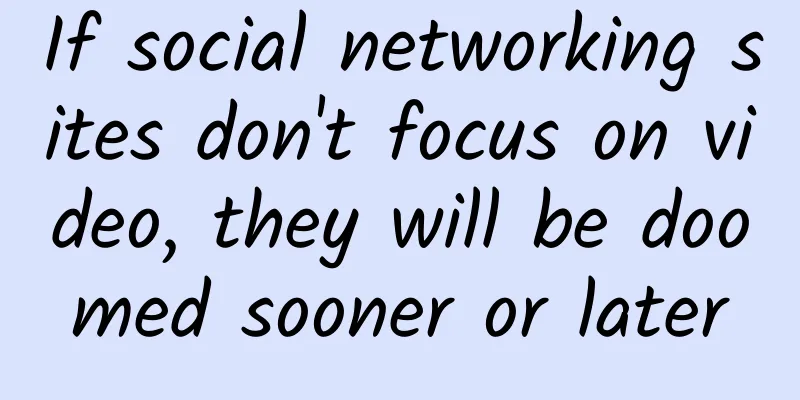If social networking sites don't focus on video, they will be doomed sooner or later

|
How has Zha Ge learned the values of socialism with Chinese characteristics? From the obstacles Facebook encountered in Shanghai last year to Lu Wei's visit to the Facebook campus this time, plus the tentative contacts in the past few times, I believe that the international friendship between comrades should have sparked. Moreover, "A journey of a thousand miles tests a horse's strength, and time reveals a person's heart" is a famous saying about how to make friends. After so much trouble, Zha Ge should have "a journey of a thousand miles" and "time of a thousand miles" ready, and it's about time to see a person's heart. Zha Ye's heart, of course, is to be a good comrade, and now perhaps he has found the trick. Therefore, relying on our good imagination and long-term experience of classism, the visual sense of the "Facebook Party Branch" came to our faces, and also attracted a lot of bricks and eggs, with the classic effect of retracing the steps of the masses. But in addition to Zago's move, there is another piece of news. Last week, Instagram announced that its monthly active users exceeded 300 million, surpassing Twitter's 284 million monthly active users. Wired magazine published an article saying that "Instagram is getting better and better at spreading news, which is enough to make Twitter panic." How to look at these two things together. Seriously, there is really no need to criticize Zuckerberg. From the perspective of the market and capital, it is only a matter of time before Facebook enters China. This shows that the market is cruel. The user growth of mainstream social networks has indeed gradually stagnated. It is impossible to really vacuum up the Chinese market. Moreover, even the big brother Facebook has been constantly acquiring emerging social products in recent years to maintain Wall Street's confidence. Why is user growth so important? This is nonsense. Specifically, due to the lack of revenue effect in the entire social network field, it is necessary to use the "user growth" as a booster to maintain its star effect at the capital level. The prerequisite for solving the revenue dilemma is to solve the content dilemma Revenue for social networks has always been a headache. Having said that, if Twitter had not spent huge amounts of energy and resources on revenue generation, it might not be easy for Instagram to surpass Twitter in terms of user numbers in a short period of time. When the user growth of a social network reaches a certain scale, the strategy of extending to the revenue direction will always encounter difficulties, and the revenue dilemma often hinders the company's self-growth, and in turn, often restricts the healthy growth of its users. The two issues are two sides of the same coin, restricting each other and forming a cause and effect. Therefore, if the specific revenue direction of the social network is not resolved, it is estimated that Instagram will face the same crossroads next. Although the revenue models of social networks vary to some extent, they are basically advertising-oriented. However, except for Facebook, the remaining few have not produced convincing financial statements. The problem is that social networks lack a universal monetization solution that can support the development of the industry. For example, videos gain growth through patches and content placement, and games achieve commercialization through props and purchases. This revenue plan can support the overall development of the video and game industries and is widely used in the industry. However, for social networks, the scale of advertising output is actually limited, and the revenue growth of social networks driven by advertising is not satisfactory. So can we say that "social + advertising" is really not feasible? The ultimate vision of social networks is to extend the real world to the Internet as perfectly as possible and recreate a human society. (If people no longer need to use intermediaries to connect directly to the Internet and virtual technology is improved, this goal may be achieved.) However, the primary role at this stage is still the media attribute. Therefore, from the perspective of the media, the experience of the media industry is very meaningful for measuring the development of social networks. That is, the root cause of the media's revenue difficulties in recent years actually comes from the content dilemma. The media's solution is to first solve the content construction problem, and it has achieved good results. Secondly, in order to further ensure revenue diversification, "social business" is also a path choice for the media industry, based on service orientation. At this stage, social networks do pay attention to and invest in "community business", whether it is the introduction of e-commerce or the improvement of payment links. However, they are strangely indifferent to content. For the media, content undoubtedly bears the responsibility of forming the front-end traffic pool, while community business is in the middle and back links. The practice of social networks focusing on "community" first and ignoring the front end is illogical no matter how you look at it. According to a recent report by Adweek, an authoritative American media, in order to increase revenue, Twitter plans to insert mandatory video ads into users' information streams. However, there is a huge debate within Twitter over whether this will affect the user experience. From the perspective of media development, there is really nothing to argue about. If we continue along the path of advertising, against the backdrop of audio-visual consumption (dynamic audio-visual content of film and television dramas, etc.) dominating the advertising market, video advertising is undoubtedly the general trend and the jewel in the crown of the huge advertising market. Therefore, the question is not whether to use video ads, but under what circumstances social networks use video ads, which can not only solve experience problems but also help solve revenue difficulties. On the other hand, although social networks are flooded with content, the noise ratio is very high, and users are not satisfied with the acquisition of effective content. Therefore, it is ironic that in the face of massive information, social users have always faced the problem of "content hollowing out". For mainstream social networks that have never paid attention to content construction, this may be regarded as an important reason for the gradual stagnation of their user growth. Technical filtering at the tactical level cannot solve content problems Strictly speaking, it is unfair to accuse social networks of not paying attention to content construction. The pan-socialized content production brought about by media factors has led to a increasing scarcity of high-quality content, causing the entire social network to be in a state of content hunger, but social networks are not indifferent to this. In mid-2014, Weibo launched an information flow optimization plan, which attempted to solve the problem of Weibo's content flooding by restricting the display of low-quality information with high exposure and low interaction, eliminating invalid content in the information flow, and resolving the embarrassment of users' inability to obtain effective content. However, Weibo chose to use "technology" to improve the connection relationship and filter out noise while encouraging the production of UGC (including PGC from self-media). This is still a patchwork approach that only treats the symptoms and not the root cause. Of course, this kind of technology-based content construction is a necessary underlying solution, not a strategic design to solve the substantive problem. Although technical filtering can filter out better content, it is still a rehash of old ideas and does not essentially solve the problem of the low overall proportion of high-quality content in social network content libraries. To take a step back, even if technological improvements can help increase UGC output, under the current conditions, the total amount of content will change only slightly and will still not change the overall proportion of high-quality content. Therefore, from an operational perspective, content production driven by technology is a tactical behavior, not a strategic one. Faced with the current situation where many mainstream social products are stuck in a situation of stagnant user growth, specific tactics can no longer solve macro problems at the industry level, because tactics cannot change the attributes of a basically established social product. The effectiveness of tactics cannot fundamentally solve the current problem of continued expansion of social networks. According to recent news, Weibo is also going to follow JD.com and Alibaba to occupy positions in rural areas. This is a good thing, but strictly speaking it is still at the tactical level. The problem is that if Weibo does not change its product attributes, it will not only bring a wave of prosperity to the city by attracting farmers, but will also return to the current user status after settling down. After all, people's sensory experience of external objects is the same. At present, the retention time of users in Beijing, Shanghai and Guangzhou is not as long as in the past. This is a fact. If we continue to imagine that users in third- and fourth-tier cities can stay on Weibo for a long time, this is a way to continue to dig a hole for ourselves. I remember Wang Gaofei said something like, fortunately, there is no new social product that is different from the current mainstream architecture to compete with Weibo in the third and fourth tier regions. But we think that this worry is necessary. Because media is "connection". "Social networks" that are naturally based on "connection relationships" are actually the closest to the media environment and are at the center of the entire media environment. In the current media environment, which is constantly changing, new social products are changing very quickly, which does not mean that they will appear and grow rapidly in the short term. If you cannot respond to the changes quickly, you will undoubtedly be in the process of going against Marx. At the same time, as a member of the media industry, social networks have already seen clear changes in the media industry brought about by the media upheaval, that is, the reconstruction of the media industry is first and foremost about the reconstruction of media content, and this reconstruction plan was basically finalized in 2014. In this case, the restart of content construction on social networks is not only a requirement of the media environment, but also an urgent need of users. Rebuilding content may be able to fundamentally change the old attributes of social networks at this stage, bring users a different product experience, and reverse the embarrassing situation faced by mainstream social networks. Rebuilding content around audio-visual content is the core of the advertising model As an online community brought about by the upgrading of Internet technology, is it true that social networks, which are based on relationship chains and promote content production and consumption, should be naturally classified as UGC as we have always seen? Is there a blind spot in this deep-rooted cognition? Secondly, as a media, social networks at this stage have not been able to break away from the old situation of mainly using text and pictures as content, even as traditional media such as print media are beginning to shift towards video services. In this field, advertisers’ budgets are fleeing due to the proliferation of production caused by the lowering of barriers to entry. At the same time, as audio-visual content is gaining further momentum, advertisers’ budgets are also beginning to shift to audio-visual content on a large scale, while social networks seem to be indifferent to this. In fact, a year ago, Twitter and TV channels such as ESPN had already cooperated to allow TV stations to insert program-related videos into information streams for TV promotion. American TV stations also insert Twitter users’ comments and data into live broadcasts in real time. However, Twitter's positioning does not seem to be to provide more and better quality content, but rather to be marketing-oriented in order to achieve revenue breakthroughs. And from subsequent actions, Twitter does not seem to have the ambition to distribute and broadcast "audio-visual content". It feels like picking up sesame seeds and losing watermelons. Some people may question whether "audio-visual content" is suitable for distribution by social platforms. In fact, audio-visual content itself is no longer pure media content in the traditional media era. Against the backdrop of the rise of the IP industry, "audio-visual content" is the content form that is most easily industrialized by IP, and its role positioning has strong product attributes. For products, social networks are not only a good promotion platform, but also a good distribution channel. Take Weibo as an example. Compared with other sub-community platforms, Weibo's free discourse environment allows UGC to have a more objective perspective and position, which is why the product reputation spread on Weibo is more trustworthy. At the same time, the discourse channels of sub-community platforms are relatively closed, and the discourse environment is relatively easy to control. For example, Taobao’s practice of “deleting negative reviews” often makes the product experience that is truly retained become the hardest hit area for fraud. The reason is that Taobao itself is not an active community discourse ecosystem, and it is impossible to conduct large-scale and uninterrupted speeches and statements to cover the false reviews that are constantly produced on the platform. The open discourse environment of Weibo naturally has the ability to purify rumors, allowing users to use the product experience left by others to make decisions on what content to watch or what products to buy. Therefore, compared with pure Internet TV, this is undoubtedly a huge advantage. In addition, there is a consensus that commercial videos attach importance to community. Social networks should reverse the overall attributes of their products before the community construction of online videos. Otherwise, whether it is the community and socialization of online videos, or the audio-visualization of social networks, what they are competing for is still the user demand market that is still blank. If social networks can accomplish this, it will certainly be a good thing for videos. However, if videos can accomplish this, it will not be a good thing for social networks. A sudden idea is that Youku and Weibo can be bundled together to form a new entity for operation, relying on the same godfather. Haha, do you want to try it? In this industry context, it is not wise for Twitter to simply add video ads to the information flow with text and pictures as the main content. Assuming that Twitter has a solid audio-visual content like online videos as a foundation, users will tolerate it. After all, as a content consumption cost, you show me video ads, and I watch the high-quality audio-visual content you provide is a fair exchange. However, Twitter's promotion of audiovisual content is a marketing act in itself, and it also plays ads on marketing content, which not only damages the rights of TV stations, but also deceives users. Therefore, we fully understand why Twitter is quarreling internally. And if Twitter wants to grow rice on the dry muddy land of the Loess Plateau, then God may not be able to save this old virgin land that lacks water. Conclusion: The future of social networks Social network is actually a very broad term, and even the entire network itself is a huge social network. However, professionals in the social field tend to overlook the fact that social products are often short-lived because they are in an environment of technological explosion. The use of technology is basically to "make things easier", and often the "middle links" are deleted or even omitted through technology, which is "disintermediation" in a broad sense. However, "disintermediation" has a deeper meaning, that is, the realization of "direct connection", which actually changes the "medium". As the operator of media relations, social networks use media technology as the foundation to form product structures. However, as the user scale grows and user needs expand, products gradually expand and become heavier. Once new media technologies bring about a change in the "way of connection", it is difficult to completely replace this bloated product structure from the bottom up. Therefore, almost every social product will fall into a growth trap after entering a certain stage. Facebook is awesome, but it still fell into a mess in the end. With the emergence of new social forms, Facebook has also faced crises. It is obviously wise for Zuckerberg to intercept the overflow of users by acquiring new social products. Although it is a defensive strategy, it can undoubtedly gain strategic buffer and time for the transformation of its old social products. To this day, can we still say that Zuckerberg's acquisition of WhatsApp for $19 billion is an idiotic act? We can only say that Zuckerberg has a deep vision, is forward-looking, and is professional enough in the field of social networks. For social networks, it is of course one thing to focus on the user level, but it is also necessary to focus on the development of new media technologies, and first think about how to implement new media technologies and enter the practical level. For example, current media technologies are causing the advertising value of content to quickly migrate from content in the form of "pictures and text" to audio-visual content. If social networks adopt the advertising model, they must be aware of this. At the same time, social enterprises that have successfully established themselves are limited by their size and are relatively slow in turning around, often lagging behind the "light, fast and agile" entrepreneurial teams. Therefore, it is very necessary to use resource advantages and technological advantages to seize a position in advance before emerging social products emerge. This is not to take the lead, but to leave themselves a way for sustainable development. Of course, you can also view it as a change in social attributes brought about by changes in user behavior, but personally, I think that if you wait until user behavior is completely reversed before you make corrections to your social products, it may be too late. As a winner of Toutiao's Qingyun Plan and Baijiahao's Bai+ Plan, the 2019 Baidu Digital Author of the Year, the Baijiahao's Most Popular Author in the Technology Field, the 2019 Sogou Technology and Culture Author, and the 2021 Baijiahao Quarterly Influential Creator, he has won many awards, including the 2013 Sohu Best Industry Media Person, the 2015 China New Media Entrepreneurship Competition Beijing Third Place, the 2015 Guangmang Experience Award, the 2015 China New Media Entrepreneurship Competition Finals Third Place, and the 2018 Baidu Dynamic Annual Powerful Celebrity. |
<<: Why are domestic game consoles not doing well as shown by the “worst games”?
Recommend
What to do if your cat is lost? Here's a step-by-step guide to finding your cat
Nowadays, there is a consensus among the scientif...
Hisense TV's crazy expansion of content pool may lead to crisis
On March 18, Hisense signed contracts with 11 vid...
If I give you 10 million, do you know how to spend it? Mainstream channel promotion and delivery combination strategy
This article is based on the industry background ...
What causes urticaria: What is the essence of SEO?
Have a website and don’t know how to optimize it?...
Why is "Airbus" a Chinese scam that fooled many media outlets?
If I tell you that a technological invention that...
Is it reliable to determine parent-child relationship based on blood type? Why is it so difficult to determine parent-child relationship based on blood type?
Audit expert: Jin Tao Chief Physician of Hematolo...
“Exclusive broadcasting” makes Mango TV’s ecosystem a success: The secret behind Mango TV’s 70-fold growth
In April this year, Hunan Radio and Television de...
40th Anniversary Walkman: NW-ZX505 Hands-On Review
For all music enthusiasts, Sony's Walkman ser...
Rowhammer vulnerability: After PCs are affected, Android devices are also vulnerable
[[175834]] Previously, the Rowhammer hardware vul...
Kuaishou advertising process and conversion rate improvement techniques!
Kuaishou - "Record the world, record you&quo...
Deloitte Consulting: 2024 US Generative Artificial Intelligence Report
Deloitte has released its 'Generative AI in t...
China Economic Information Service: 2017-2018 China Internet of Things Development Annual Report
The Annual Report analyzed that since 2017, the g...
Font size is bigger and clearer! WeChat: Nearly 4.07 million users have activated caring mode
[[427576]] News on October 8, today, WeChat offic...
Cao Maogui's stock market secrets: intraday T+0 operation methods and skills 1 video
Cao Maogui's stock market secrets: intraday T...
Why BMW chose its new design chief from Skoda
Although there was much speculation about Karim H...









